El Nino Wreaks Havoc
The complex, interrelated geology of the Andes, the Atacama Desert, and the Atacama Trench all come together in the face of El Nino, a weather pattern that affects the whole planet. The microscopic plankton that grow in the sunlit waters of the upper ocean provide the foundation for the ocean's food chain, just as grass […]
A 22,000-Year Rainfall Record
Desert conditions have seemingly always dominated, with only temporary periods that proved less harsh as a result of global climate changes. For instance, a recent report in Science presented a detailed account of rainfall in the Atacama going back 22,000 years. The researchers from the U.S. Geological Survey, the University of Arizona, and the Universidad […]
Detecting Life
When scientists wanted to test the robot destined to explore Mars, they took it to the driest, most lifeless place they could find, the Atacama Desert. They hoped that the austere desert could help solve a mystery and prevent a blunder. Even before H. G. Wells wrote his terrifying War of the Worlds, scientists wondered […]

Atacama: The Oldest Desert: South America
T he ancient, cold Atacama Desert might as well be on another planet. In fact, when scientists wanted to find a place harsh enough to test the robots they planned to send to Mars to look for the faintest, most beleaguered traces of life, they came first to this 700-mile-long (1,100 km) desert in northern […]
The First Bird
Another fossil from the same area revealed new insights into how birds developed the ability to fly, according to findings in Science. The fossilized bones and feather impressions of the pigeon-sized bird dubbed Apsaravis ukhaana were uncovered in Ukhaa Tolgod in the Gobi. The creature appears to be very close to the root of the […]
The First Indiana Jones
Roy Chapman Andrews had a very odd dream for a young boy roaming the hills of Wisconsin. He wanted to work for the American Museum of Natural History in New York City. But his life exceeded even his wildest dreams and included dinosaurs, bandits, international fame, and a career so exciting he became the model […]
Sand Dunes Swallow Dinosaurs
Despite the scale of the great Gobi sand dunes, it is still startling to learn that more than 65 million years ago those sand dunes were big enough to bury a dinosaur in an instant. At least, that is the conclusion of an international team of scientists who published a study in Geology. The Gobi […]
Wildlife of the Gobi Desert
The harsh conditions of the Gobi have forced the creatures that live there to adapt and survive. Although much of the desert consists of sandy or stony plains, the mountains, canyons, springs, marshes, and fitful river systems provide enough diversity of habitat to shelter an array of fascinating creatures. These include wild Bactrian camels, several […]
Sand and Soil
Sand defines the Gobi Desert, the dried-out remains of soils that once sustained life during the ice ages. Unlike soil, sand lacks the organic material to nurture plant life. Experts still puzzle over the source of the great, hypnotic fields of massive sand dunes that dominate hundreds of square miles of the nearly rainless desert. […]
Alshan Plateau and Junggar Basin Semi-Deserts
Two major areas adjacent to the deep desert, the Alshan Plateau and the Junggar Basin, transition from barren sand to arid grasslands. The Little Gobi desert lies in the southwestern portion of the larger desert area. Higher and wetter, it fills the space between the Yellow River on the east and a mountain chain. It […]
Eastern Gobi Desert Steppe
The region most typically desert is the Eastern Gobi desert steppe, which covers some 109,000 square miles (281,800 sq km) and extends from the Inner Mongolian plateau in China north into Mongolia. High and cold with elevations from 2,300 to 5,000 feet (770–1,700 m), this region gets as much as eight inches (200 mm) of […]
Plate Tectonics: The Restless Earth
The Earth's surface is divided into several major crustal plates, layers of light rock 30 to 100 miles ( 48– 160 km) thick floating on top of the Earth's heavy, iron-rich mantle. Currents that originate in the molten, super-dense core trigger inexorable currents in the mantle above. The currents in the mantle, in turn, push […]
Cutting Off the Moisture
The collision of continents ultimately isolated the portion of central Asia that includes the Gobi Desert from the moisture-laden winds from the ocean. The winds blowing up against this barrier of mountains rose until the moisture it contained condensed into rain or froze into snow. The Gobi sits surrounded by such a ring of mountains, including […]
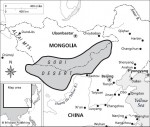
Assembling a Continental Desert
Almost unimaginable forces raised the vast network of surrounding mountain ranges that created the Gobi Desert. Understanding the creation of the Gobi requires an understanding of plate tectonics and the theory of continental drift. Geologists have discovered that the Earth's surface is divided into a series of crustal plates that include both heavier oceanic material and […]
Gobi Desert: Central Asia
T he dry, wind-tormented sands of the 500,000-square-mile (1.3 million sq km) Gobi Desert harbor deep secrets—from the evolution of life to the restless stirrings of the planet. The high, windy, bone-dry region is a continental desert as a result of the mountains that surround it and cut it off from moist, ocean air in […]
Living in Dreamtime
Perhaps the most remarkable adaptation of these desert-dwelling people was their rich, mystical culture, layered with stories and stitched together with faith and insight into the natural world. The Australian aboriginals boast the longest continuous cultural history of any group on Earth. Central to their view of the world is the mysterious and transcendent notion […]
The Aboriginals: The Oldest Culture
The Australian deserts also harbor one of the most remarkable, desertadapted cultures, the Australian aboriginals. They adapted to the harsh conditions and their long isolation with a culture sparing in the use of tools but rich in philosophy and cultural adjustments to desert conditions. Moreover, their long isolation from other human cultures has made them […]
Kangaroo Hops Happily through Hard Times
The kangaroo remains the most distinctive and recognizable marsupial in Australia. Although Australia separated from Antarctica and begin drifting north 6 million to 1366 million years ago, the ancestors of the first, ratlike marsupials hopped out of the trees some 0 million years ago. They eventually gave rise to kangaroos and their various relatives, all […]
Disastrous Explorations
Ironically, although the aboriginals could not withstand the Europeans in safe territory, the Europeans could barely survive in areas the aboriginals considered home. Australian history is filled with tales of disastrous attempts to explore the interior. The most renowned of the Australian explorers was Ernest Giles, who led three major expeditions to explore these great […]
Australian Deserts: Australia
T he hard, sprawling deserts of Australia and the remarkable people who have lived in them for 50,000 years offer fascinating clues to human evolution, climate shifts, and the intricate connections between living things and the ecosystems they inhabit (an example is shown in the color insert on page C-8). Although Australia boasts tropical forests […]
Weaverbird Communes
One of the most remarkable creatures of the Kalahari Desert is the sparrowlike weaverbird. Small, gray creatures, they are unremarkable unless they have gathered in a group, when they become one of the planet's most interesting and sociable birds. Hundreds of birds form a single flock, which then cooperatively weaves a giant nest of twigs […]
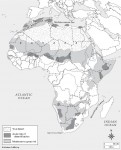
Great Animal Migrations
Any creatures that live in the Kalahari must therefore either survive without relying on easy access to surface water or migrate through the area during the times when the scarce rains fall. Perhaps the most distinctive feature of the Kalahari is the way in which it blends into the larger, surrounding stretch of arid grasslands, […]
A Fossil Desert
In many ways, the Kalahari is more of a fossil desert than an actual desert. The great sand-covered plateau that includes the Kalahari is testament to desert conditions that once more closely resembled the Sahara than the current semiarid grassland mitigated by scattered acacia trees and shrubs, which fill the same niche that plants like […]
The Bushman Diet Drug
Ironically, the wisdom of their traditional culture may harbor treasures that could mitigate their otherwise brutal poverty. For instance, the San Bushmen have long chewed pieces of the hoodia cactus to take the edge off hunger, since they sometimes had to go days with little or nothing to eat on long hunts or in times […]
Studying the Human Mystery
Thus, the lifestyle of the Bushmen who have lived in balance with the demands of the desert grasslands of the Kalahari for at least 30,000 years may provide invaluable clues to human origins and our original huntergatherer lifestyle. The traditional Bushmen were renowned for an intimate knowledge of the desert that enabled them to make […]
The Original People
Once upon a time, paleontologists believed that human beings and the other primates went their separate ways 15 to 30 million years ago. They based the conclusion on inexact and wide-ranging dating of bits of teeth and skulls scattered throughout the world. Moreover, paleontologists found bits and pieces of big-brained, upright-walking hominids they believed gave […]
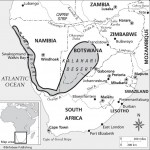
Kalahari Desert: Southern Africa
Odds are, human beings hit upon the lifestyle and innovations that enabled them to populate the planet in some place very like the Kalahari Desert, a small, surprisingly diverse, just-barely desert in southern Africa that still harbors what many geneticists consider the original human beings. The 100,000-square-mile (260,000 sq km) Kalahari is a faint echo […]
The Ship of the Desert: The Camel
The camel remains one of the most remarkable and important of all desert-adapted animals. Consider the following facts about the camel: Go seven months without drinking, if they can get moisture in their food Go two weeks without a drink even if they eat nothing in the heat of summer Lose 0 percent of its […]
Strange Animals Thrive in Harsh Conditions
Many of the most unique and specially adapted creatures of the Arabian Desert have already disappeared or cling to a rootlet of survival. One remarkable creature that has vanished from most of the desert is the ferocious honey badger, a 10-inch-long (250 mm), 25-pound (11 kg) mass of muscle and aggression also known as the […]
Plants Cope with Salt and Heat
Surviving in such a harsh, hot, waterless place demands special adaptations in desert plants. Most have made elaborate adjustments to the lack of water. Many are halophytic, or salt tolerant, having evolved ways to handle loads of salt and minerals that would kill most plants. Many of the low-lying areas into which the wadis drain […]
For Deserts—Location, Location, Location
Sprawling along 22? of latitude, most of the Arabian Desert lies north of the tropic of Cancer. Summer heat reaches temperatures of 129°F (54°C). Although some of the coastal stretches get moisture in the form of ocean fogs at night and in the morning, most of the sandy expanse gets less than 4 inches (100 mm) […]
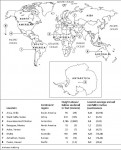
A Landscape of Sand
The great, flat sandy plains separating both the volcanic mountain ranges and the uplifted plateaus dominate most of the Arabian Desert. Covered with rocks or gravel fitted into something of an armor plating by the patient actions of wind and frost, these desert pavement surfaces protect the dry, sandy soil beneath. Some of the plains […]
Hidden Riches of the Arabian Desert
That long, rich geologic history helps explain the vital importance to the world of this seemingly barren and inhospitable desert. In its northern reaches, the 1,300-mile-long (2,080 km) Arabian Peninsula merges with Arab Asia through the treeless plains of Syria. The highest point lies in Yemen, 12,336-foot (3,760 m) Mount Al-Nabi Shu'ayb. Much of the […]
The Arabian Horse
The oldest purebred horse, the magnificent Arabian, which starred in The Black Stallion, has played a key role in human history and the development of our intimate relationship with the horse. Distinguished by their narrow, delicate faces with large nostrils and a teacup muzzle, the Arabian's lineage dates back to at least 500 B.C. It […]
Arabian Peninsula Nourished Civilization
Oddly enough, the same titanic forces that created the Arabian Desert at the head of this great rift system also nurtured the rise of Western civilizations and three of the world's dominant religions. North of the Red Sea, the Suez Canal connects directly to the Mediterranean Sea, which is shrinking as a result of the same […]
The Birth of an Ocean
Even today, the geology of this desert caught between Africa and Eurasia remains dynamic. For instance, the Earth's crust is splitting apart along the long, narrow gash of the Red Sea, which runs between the Arabian Desert and Northern Africa. The gaps between Africa and Eurasia began opening 35 million years ago along the 1,600-mile […]
Arabian Desert: Middle East
T he great, sand-swirled Arabian Desert that includes almost all of modern-day Iraq and Saudi Arabia is all about beginnings, both the genesis of Western civilization and the birth of an ocean. Moreover, the remarkable geology of the region sustains modern civilization with the compressed ooze of eons past in the form of the world's […]
What Lies Ahead for the Sahara?
The Sahara remains the most sparsely inhabited place on the planet, with the exception of the frozen wastes of Antarctica. Most of the herders and traders who once made a living here have vanished, their cultures crushed by contact with outsiders and shifts in trade routes that no longer require goods to cross the harsh […]
Animals Also Evolve Ingenuous Adaptations
The Sahara once had a broad, vital array of animal species, including elephants, lions, ostrich, and a host of other species. But many animals vanished as the climate shifted, the desert expanded, and human beings killed off the fragile survivors. For instance, a hunter killed the last known antelopelike addax in the northern Sahara in […]
Plants Outwit Drought and Heat
Few plants can deal with the combination of heat, cold, and dehydration. Large areas in the shifting dune fields have only a handful of plants struggling to grow fast enough to avoid burial. In the low-lying areas that once held great lakes, only salt-tolerant halophytes can detoxify concentrations of salt and minerals that would cause […]

In the Grip of a Dry Climate
The Sahara remains the preeminent example of a midlatitude desert formed as a result of the way in which heating at the equator drives the atmospheric circulation of the whole planet. Moist, heated air rises high into the atmosphere at the equator, which draws the steady flow of the trade winds in the midlatitudes. The […]
Living on Million-Year-Old Water
One recent study demonstrated that the Sahara's hidden but increasingly hard-pressed supply of groundwater is actually fossil water that fell as rain more than a million years ago. This source of groundwater fell from the sky when the African continent was farther south, the current Mediterranean Sea was a low-lying desert, and the Sahara was […]
The Ghost of Water
Most of the rugged, sandy terrain of the Sahara drains into expansive internal basins or, in the north, into the ghostly tributaries of the Nile River. A few rivers that arise beyond the limits of the desert drain into it, contributing to its fitful supply of streams and its ancient supply of groundwater. The greatest […]
Sand Dunes Sing
The dunes of the Sahara sometimes sing by emitting a low, haunting humming or booming sound. The still poorly explained sound puzzled some early explorers. Marco Polo in the the century blamed, “evil desert spirits [which] at times fill the air with the sounds of all kinds of musical instruments and also of drums and […]

The World’s Biggest Sand Dunes
The Sahara is best known for its massive sand dunes. These sand dunes cover about one-quarter of the Sahara, the tallest, most complex, most extensive dune fields in the world. These dunes are the result of powerful, constant, continental winds moving sand left over from a time when the Sahara had lakes, streams, and floods, […]
The Geology of the Sahara
Today, the vast, hostile Sahara remains the mother of all deserts. High points like 11,204-foot (3,415 m) Mount Koussi in Chad rise like stone fortresses in a great battlefield of sand. A series of ridges and mountain ranges are separated by great, stretched, low-lying depressions, like the Quyattara Depression of Egypt that lies 436 feet […]
Blame the Plants for Speed of Sahara Expansion
It is important to note that even after taking into account the effects of the Earth's wobble and the shift in summer temperatures, climate experts cannot account for the speed with which the grasses withered and the Sahara expanded. Blame the plants, concluded a team of German scientists led by Martin Claussen, which published its […]
A Devastating Desert Expansion
Starting around 6,000 years ago, the Sahara Desert started an abrupt and devastating expansion. In a geological blink of an eye, the boundary between hard-core desert and grassland shifted by about 500 miles (800 km), which increased the size of the desert by nearly 50 percent. Moreover, the summer monsoons that had sustained the grass-harvesters […]
Telltale Stone Tools Yield Clues
Other studies have yielded similar conclusions and demonstrated how important the much-wetter Sahara was to human beings as they developed the culture and technology that would eventually enable them to dominate ecosystems on every continent. For instance, mysterious nomads wandered across the Sahara Desert between 8,000 and 5,500 years ago, according to a National Science […]
A Mystery 1,000 Years Older Than Stonehenge
Other studies have shown that human beings thrived in the Sahara for 100,000 years or more in areas now virtually uninhabitable. For instance, scientists have discovered the earliest known observatory for marking the movement of the stars, which ancient people could have used in religious ceremonies and in planning their migrations and crop plantings. Some […]
Can Snail Shells Solve a Mystery?
Things have changed dramatically in the Sahara, according to Washington University Assistant Professor of Earth Sciences Jennifer Smith, who has studied ancient snail shells taken from some of the Sahara's vanished lakes. Specifically, she dug shells of the freshwater gastropod Melanoides out of silts laid down in the bottom of a small lake in the […]

Sahara Desert: Northern Africa
Something happened. Something bad. Something strange. Some 6,000 years ago, the region of North Africa that today constitutes the world's greatest desert was a lush grassland studded with scrubby trees, lakes, and streams. Antelope, rhinos, hippos, lions, jackals, giraffes, clams, fish, and human beings wandered about in well-hydrated content. That hospitable grassland habitat dated back […]
The Battle of the Bulls
One of the strangest battles of the Mexican-American War was fought on the banks of the San Pedro. Under the leadership of Brigham Young, members of the Church of Latter-day Saints had settled in Mexico seeking a refuge from religious persecution when the Mexican-American War broke out. Young believed that if he offered the United […]
San Pedro River: A Linear Oasis
The San Pedro River marks the western edge of the Chihuahuan Desert. It is a small, struggling, vital, and enormously diverse river, thronged with ghosts. The last undammed river in a region where an estimated 90 percent of the precious riparian areas have been destroyed or degraded, the San Pedro nurtures great, leafy meanders of […]
Living on Algae’s Efforts
In most of the dunes, plants need special adaptations to deal with the gypsum, or calcium carbonate, in the soil. Plants that have evolved special techniques for dealing with such calcium carbonates are called gypsophiles, and the Chihuahuan Desert has more such plants than any other desert. Fortunately, a variety of algae has also developed […]
Chiricahua Mountains: Between Two Deserts
Sitting on the northwestern edge of the Chihuahuan Desert, the Chiricahua Mountains mingle cataclysmic geology with a bloody history. The 150-mile-long (241 km), 9,700-foot-tall (3 km), ecologically extravagant range of tormented rock is the most extensive and varied of southeast Arizona's famed Sky Islands and serves as a vivid lesson in how geology shapes both human […]
White Sands National Monument
The Chihuahuan Desert also harbors another geological marvel, the blinding white dunes of White Sands National Monument in New Mexico. These dunes are made of gypsum left behind by the evaporation of a once-vast Ice Age lake. The gypsum crystals are soft and easily scratched, which means that the tiny crystals reflect the light that […]
Carlsbad Caverns National Park: Fantastic Realm
One of the most remarkable geological features of the Chihuahuan Desert actually lies far beneath the surface, the Carlsbad Caverns, a vast limestone cave decorated with a fantasy of natural stone shapes. The cavern is the most spectacular and accessible of many such caverns that have formed in the once-sea-bottom layers of limestone that underlie […]
Big Bend National Monument: Hard and Historical
This 2,865-square-mile (7,420 sq km) region in a bend of the Rio Grande exemplifies the austere terrain and the complex geological history of the lower-elevation areas of the Chihuahuan Desert. Lying in a great, down-dropped trough, the park features the typical basin and range topography of low flat basins surrounding sharply uplifted, isolated mountain ranges. […]
Creatures That Never Take a Drink
Any creatures living in a desert where eight months without significant rain is routine must have intricate adaptations to these conditions. For instance, the desert pocket mouse can go its whole life without a drink of water. The tiny, big-eyed rodents dig burrows up to five feet deep (1.52 m), usually with at least two […]
A Tale of Hungry Bats and Lush Flowers
Gary Paul Nabhan and Stephen L. Buchmann in The Forgotten Pollinators detail the remarkable relationship between the bats and the agave. Nectar-feeders like the long-nose bats travel a looping 3,200-mile (5,150 km) migratory route every year that appears precisely timed to take them from wintering caves deep in Mexico to caves in which they raise their […]
Century Plant Grows Fatally Tall to Survive
The massive century plant is one of the most distinctive plants of the Chihuahuan, a tough, sharp-spined member of the lily family with a dramatic strategy for spreading its seeds. One of the largest agaves, the century plant may persist for 50 years before it reproduces in a single season of fatal extravagance. Normally, the […]
The Mystery of the Cataclysm
Some million years ago as the Basin and Range Province took shape, a long, violent series of volcanic eruptions shaped the face of the Big Bend area and much of the rest of the Chihuahuan Desert. This period of intense volcanic activity shaped much of the American Southwest. In some places, great bubbles of molten […]
Chihuahuan Desert: Arizona, Texas, Mexico
The same forces that have shaped the other North American deserts by creating the geologically stretched Basin and Range Province also forged the 280,000-square-mile (450,616 sq km) Chihuahuan Desert. This great desert plain punctuated with a patterned scattering of northsouth trending mountains starts in the shadow of the massive Sierra Madre in Mexico, runs north […]
The “Blueberries” That Predicted an Ocean
The Great Basin Desert harbors enigmatic sandstone marbles that have already helped prove that Mars once had oceans. The geological mystery story starts on the Red Planet, where the robot rover Opportunity went trundling across the surface looking for signs of water and beamed back to Earth images of perplexing stone nodules, perfectly round rocks […]
Condors Make a Comeback
The rock-climbing biologists dangling in front of the cliff-face condor cave expected the worst, but hoped for the best. They wanted to know why condor and condor had abandoned their nest in the ancient cave in the inaccessible heart of the Grand Canyon. The devoted condor couple was among California condors reared in captivity who […]
Painted Desert: Cold Winds and Buried Dinosaurs
Many experts consider the sprawl of colorful high-elevation desert in the northeast corner of Arizona to be a part of the higher, colder Great Basin Desert to the north. The Painted Desert is far from the moist storms of either the distant Pacific or the Gulf of California. The deluge of summer storms that make the […]
Invaders Unhinge an Ecosystem
Ironically, an exotic grass introduced by human beings now threatens the sagebrush ecosystem that expanded so dramatically as a result of human beings and their cattle. The sagebrush populations exploded after overgrazing removed the cold-adapted native grasses. Those grasses used to carry periodic, low-intensity fires that would burn up encroaching brushes. The grass, on the […]
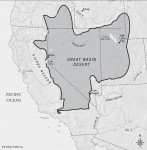
Adapted to the Sagebrush Ocean
The Great Basin Desert harbors far fewer species than the warm, summer-rain-blessed Sonoran Desert to the south. Only a handful of flowers like the plains daisy and the yellow parsley bloom in the spring. Only a handful of birds, notably the horned lark, flit through its expanses. Horned larks account for almost all the flocks […]
A Sagebrush Realm
Despite the hardships the desert imposed on travelers, the plants and animals that evolved to fit into its austere seasons and angular design demonstrate the adaptability of life, especially in the most unlikely places. The transition from the low, hot Sonoran Desert to the high, cold Great Basin Desert demonstrates the tradeoffs that plants and […]
A Lethal Barrier to Exploration
For much of the nation's history, the Great Basin Desert formed a terrible barrier to explorers and settlers, especially after the discovery of gold in California in 1848 spurred the California gold rush. Legendary explorer Jedediah Smith made the first recorded crossing of the basin in 1824, although he left no documentation of his route […]
Cataclysm Leaves Wealth of Minerals
That complex geological history has left the region with a wealth of minerals, many of them formed when the rocks in these desert ranges were deep beneath the ocean along the crack in the Earth between two crustal plates. The weak crust along such gigantic fissures lets molten rock from the deep Earth escape to […]
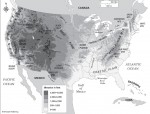
Great Basin: Terrible Thirst and Endless Sagebrush
The same forces that stretched, pulled, and uplifted the entire American Southwest also created the landscape of the Great Basin Desert, a portion of the larger Basin and Range Province, which extends from California's Sierra Nevadas down into Mexico and Texas and up to Nevada and Utah. One old survey map described the mostly north-south […]
Great Basin Desert: Utah, Arizona, Nevada
T he sprawling Great Basin Desert gives North America a cold, interior rain shadow desert to rival Asia's Gobi Desert. Haunted by the harsh winters of its 6,000–7,000-foot (2,000–2,333 m) elevation, screened from rain by the towering Sierra Nevadas and California to the west and the Rocky Mountains to the east, the Great Basin's endless […]
Grand Canyon Reveals the History of the Earth
The great gash of the Grand Canyon also provides perhaps the single most dramatic lesson in geology and the Earth's history on the planet. The Colorado River cut down through the leading edge of the uplifted Colorado Plateau in the past five million years as the same forces that created the Basin and Range Province […]
Grand Canyon: A Transformed Sliver of the Mojave
The mile-deep gash of the Grand Canyon connects the drought-adapted Mojave Desert to the frost-adapted Great Basin Desert. As shown in the color insert on page C-2, the desert plants and animals in the bottom of the canyon have evolved to adapt to the odd combination of desert heat and rampaging river in the course […]
Rattlesnakes: Deadly Adaptations
Although rattlesnakes evolved long before the world's deserts took their present form, they were exquisitely preadapted to desert conditions. The fear of rattlesnakes is greatly exaggerated, since far more people die from bee stings or dog bites than rattlesnake venom. But something about the coiled warning, slitted eyes, and flicking tongue of the venomous rattlesnake, […]
It Takes a Fungus to Make a Soil
Fortunately for the thirsty flowers, they get help from strange fungi waiting in the top two inches of these desert soils. In wet, fertile areas, the topsoil is constantly enriched by the carbon-containing debris of plants, including leaves, roots, and twigs. In the riotously productive rain forest, the mass of plant debris on the ground […]
Desert Bursts into Flower
The Joshua tree represents one set of adaptations to a place with dry summers and chilling, but still thirsty, winters. Desert creatures have developed many different solutions to those problems. For instance, desert wildflowers seem almost miraculous in their delicate abundance during a rare wet year, when a succession of winter rains or snows yields to […]
The Edge of the Desert
The monument lies on the southwestern border of the Mojave Desert. To the south lies the Colorado Desert, a division of the Sonoran Desert that includes Palm Springs, the Coachella Valley, and the Salton Sea, which in the Ice Age rivaled Lake Manly and which is now sustained mostly with irrigation water brought in from […]
Joshua Tree National Monument: As Lush As the Mojave Gets
While Death Valley represents the most extreme environment in the Mojave Desert, Joshua Tree National Monument in Southern California presents the Mojave at its balmy best. Of course, this is relative, since this high-elevation desert with its giants' playground of granite boulders and an octopus's garden of bizarre yucca swelters in summer, freezes in winter, […]
Ice Age Desert Fish Hangs On
Death Valley also harbors one of the more inconspicuous but fascinating of endangered species, the Devils Hole Pupfish. These minnowlike, almost transparent, 1.5-inch-long (38.1 mm) fish with odd, bright blue eyes live in a single, spring-fed pool that has collected in a collapsed limestone cavern. They are descended from cyprinodonts, fish that once lived in […]
Creosote: The Oldest on Earth
One of the most widespread plants in the Mojave and Sonoran Deserts is the creosote bush, which nourishes its own interdependent set of creatures. Remarkably, the creosote might live longer than any other plant on the planet, nearly 12,000 years. That is remarkable considering the low, olive-green bush with tiny leaves thrives in areas too tough […]
Desert-Adapted Species Struggle
Death Valley also boasts an array of desert-adapted Mojave species, despite its harsh conditions, even in seemingly impossible places like Badwater. Periodically, storms create shallow, fleeting ponds on the salt flat, full of minerals and salt. But that is just fine with soldier flies, which lay their eggs in the salt flats so their larvae […]
Death Valley: The Lowest, Hottest Place
The spectacularly eroded Death Valley is a strange desert in a continental sinkhole that remains one of the most bizarre and forbidding places in the world. Pine-clad mountains harboring the oldest trees on Earth overlook the breathtaking plunge into a valley that ranks as the lowest, hottest, and driest place in North America. The rocks […]
The World in a Song
The Mojave Desert–dwelling Chemuehevi Indians had few possessions, but they always had their songs. The Chemuehevi lived in the deep desert, hunting rats, rabbits, and bighorn sheep, gathering roots, tubers, beans, and berries and moving ceaselessly over a broad area. They thrived for thousands of years in desert that routinely killed settlers trying to cross […]
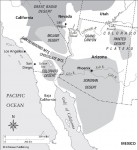
A Collision of Continents
This collision of continents created the topography of the western United States and Mexico. Initially, the collision built up the Sierra Nevadas, pasted California and parts of Washington and Oregon onto the western edge of North America, and isolated the terrain that would one day become the deserts of North America behind this rain-stealing rampart […]
Mojave Desert: California, Arizona
T he Mojave Desert is a jagged, angular land of staggering extremes. It contains the lowest, hottest place in North America, a great underground river, places of bizarre beauty, a terrible earthquake fault, dead lakes, low basins, and strange and resourceful plants and animals. It occupies some 51,000 square miles (81,000 square km) and extends […]
A Massacre That Shocked the Nation
One of the most heartrending stories attached to the Gila involves the massacre of the family of Royce Oatman, who set out from Independence, Missouri, in 50 with his wife and seven children. A successful farmer driven by some fatal restlessness, Royce set out with his family for California, where the gold rush had triggered […]
A Fragile Desert at the Mercy of Human Beings
The long, complex history of the Sonoran Desert demonstrates the intimate connection between geology, ecology, and human beings. Early human cultures depended utterly on the land and learned to survive by making the most of its whims and resources. For a time, it seemed that the Salado, Hohokam, and other desert civilizations had overcome the […]
Gila River: Plight of the Desert
Nothing so captures the human impact on the Sonoran Desert as the plight of the Gila River, once its most important river system. The river has all but vanished into reservoirs, irrigation ditches, and thickets of exotic salt cedar along most of its once epic length. The ghost river originates in the highlands of New […]
Buenos Aires: The Grassland Boundary
The Sonoran Desert remains a surprisingly fragile ecosystem and has repeatedly shifted its boundaries in response to climate changes and other influences. In wet periods, grasslands expand into desert regions. During droughts and climate shifts, the grasslands retreat and the desert expands. Even insects and animals can affect the boundary between desert and grassland. Creatures […]
The Lethal Secret of the Lost Dutchman
When Jacob Waltz and his partner Jacob Weiser emerged from the Superstition Mountains with a handful of gold nuggets, people naturally assumed they had discovered gold in the unlikely geology of the volcanic Superstition Mountains. And when Waltz one day emerged from the mountains without his partner who he said had been killed by the […]
Flowers Blossom in the Desert
The hardy desert wildflower seeds can lie, desiccated and dreaming in the desert soil for decades, waiting for the steady winter rains they need to flourish in the spring. They are testament to the gaudy persistency of life, especially flowering plants, which emerged approximately 140 million years ago. As leaves evolved into petals loaded with […]
Superstition Mountains and the Legend of the Lost Dutchman
The jagged Superstition Mountains just outside of Phoenix show another face of the Sonoran Desert, rife with alluring legends of violent death and lost gold mines. That includes one of the most famous tales of the Sonoran Desert, the lost gold mine of the mysterious, semi-mythological Jacob Waltz, better known as the “Lost Dutchman.” The […]
Casa Malpais: Death by Religious Warfare?
One of the most intriguing clues to the mystery of the regional collapse of ancient civilizations throughout the Southwest lies on a high plateau grassland that lies at the edge of both the Sonoran and Great Basin deserts—the stone ruins of Casa Malpais, a 50-room pueblo on a lava flow riddled with caves. Casa Malpais […]
More Clues in the Verde Valley
More clues to the mystery have been unearthed 100 miles (160.9 km) northwest in the Verde Valley, which harbors some well-preserved ruins constructed by the cliff-house–dwelling Sinagua, who also abandoned an ancient and adaptable Sonoran Desert civilization in the 1400s, including well-constructed stone pueblos at Tuzigoot, Montezuma Castle, and Montezuma Well. The mysterious Sinagua settlement […]
A Long Buildup and a Fast Collapse
The earliest settlers in the Tonto Basin were most likely migrants from the Hohokam core areas in what are now Phoenix and Tucson, where tens of thousands of people tended hundreds of miles of irrigation canals. But they soon evolved their own vibrant culture. They made beautiful pots, painted with elegant, curved designs suggestive of […]
A Baffling Missing Persons Case
The Sonoran Desert holds the clues to one of history's great missing persons cases, the collapse of distinct but connected 1,000-year-old civilizations throughout the Southwest sometime in the 1400s, just before the arrival of the first Spanish explorers. Human beings have occupied the Sonoran Desert for at least 10,000 years and for perhaps as long […]
Organ Pipe National Monument Preserves Desert
On the edge of the Tohono O'odham Reservation stands Organ Pipe National Monument, one of the best places to glimpse the rich ecosystem of the Sonoran Desert, with its tenacious, understated extravagance and the long sweep to the horizon. The landscape was forged in a series of cataclysms starting 110 million years ago caused by […]